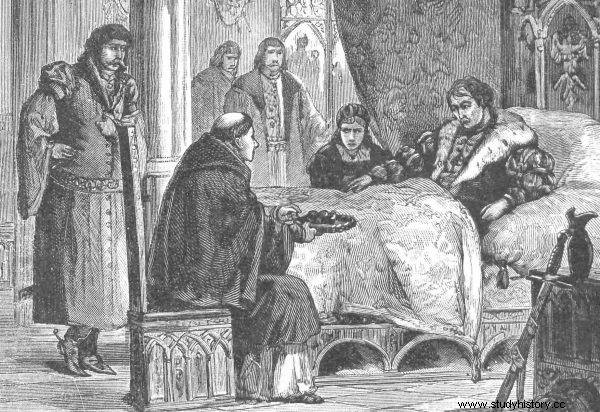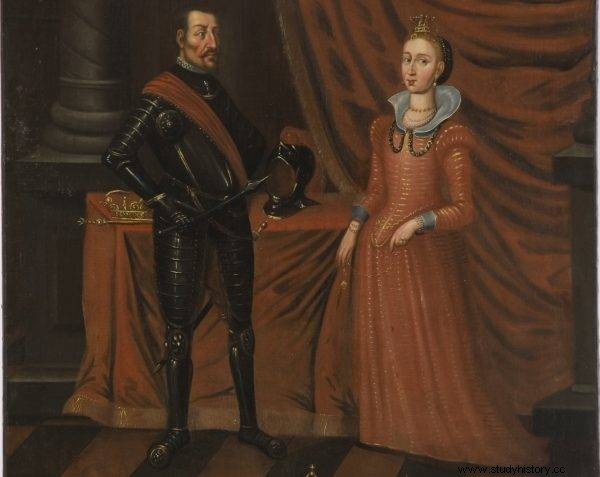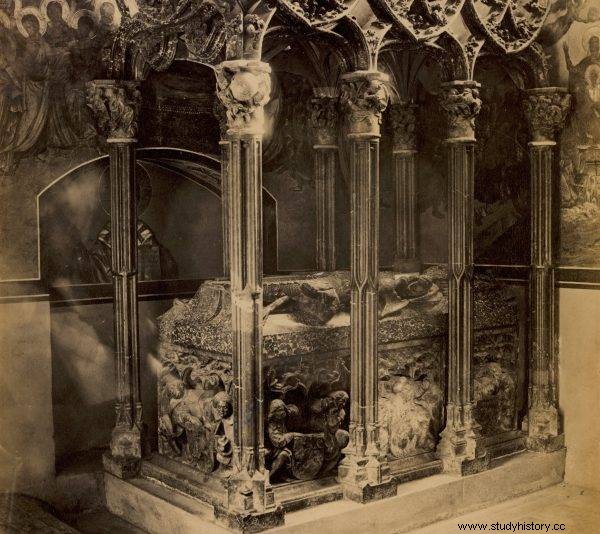Everyone has heard of Tutankhamen's curse. Similar horrific events also took place in Poland. It all started with the opening of the tomb of Kazimierz Jagiellończyk ...
It is 1973. Conservation works are underway in the Świętokrzyska Chapel in Wawel. Nothing foreshadowed the upcoming events. But one by one…
During these days, among others, crypt of Elżbieta Rakuszanka. Her body was also found. The chapel also housed the previously unopened crypt of Kazimierz Jagiellończyk. Access to it was easy - next to it was an empty crypt of the much later king, Michał Korybut Wiśniowiecki ... Why empty? Since his body was moved in the 19th century, after Emperor Franz Joseph funded a new sarcophagus for him in the crypt of St. Leonard. A glance at the Jagiellonian tomb chamber, located about 2 meters below the floor, seemed tempting.
Unlucky Friday the 13th
In order to add fuel to the fire in the context of the events that followed, let's just say that - as Stanisław Kozieł, the chief archaeologist of Wawel recalled it in his diary - more than a month before the official opening of the crypt, it was decided to visit it. It happened - attention! - April 13, 1973. Friday! And how can you not be superstitious…
On that day, it was decided to drill into the Jagiellonian's grave from the Wiśniowiecki crypt. A drill bit was launched to make a hole only 2 cm in diameter. Drilled, drilled, until after traveling a 90 cm long road, a void was finally found. Only… too much could not be seen through this small opening. The then manager of the Construction Department at Wawel, engineer Jan Myrlak, even tried to construct a lamp that could be inserted inside with a rod. All for nothing! Despite maneuvering in various ways, it was simply impossible to see the contents of the crypt. Well, you have to cut off…

On his death, Kazimierz Jagiellończyk could not have assumed that the curse hanging over his tomb would cost the lives of 15 people
It was decided to forge a fragment of the wall, which would then be removed by a commission. It was done on May 7, but as it turned out, the luck of this number was insufficient to compensate for April 13. In addition, engineer Stefan Walcz was then holding a book by C. W. Ceram (actually:Kurt Wilhelm Marek) entitled "Gods, tombs and scholars" and he was kindly reading the audience the passage about Tutankhamen's curse…
Official opening - in the presence of the Metropolitan of Krakow Karol Wojtyła, the general conservator of monuments of the Polish People's Republic, professor Alfred Majewski, director of the State Art Collection at Wawel, prof. Jerzy Szablowski and journalists - it took place later, on May 19. But not for nothing, for example, in cemeteries, the inscription Violator huius operis infelix esto - whoever desecrates this place be damned …
What was found inside the tomb?
The open burial chamber was 175-200 cm high (due to the arch-shaped vault). Its dimensions are 300 x 120 cm. There were no indications that it had ever been opened before - that is, since the burial in 1492. The coffin in which Kazimierz Jagiellończyk was buried was placed on three iron bars. When it opened, however, it was in disorder because the coffin made of one pine trunk, originally secured from the outside with a fabric impregnated with resin, has rotted and broke. As a result, the remains of the king, the remnants of fabrics and the insignia inside it lay in the chamber in a rather disorderly manner . The skeleton itself was almost complete with a few exceptions.

The king's height was estimated at 179 cm. The age at death is estimated to be around 65, which is in line with historical data.
It is worth noting that forensic medics:professor Zdzisław Marek and professor Kazimierz Jaegermann participated in the examination. The king's height was estimated at 179 cm. The age at death is estimated to be around 65, which is in line with historical data. It was found that he could have a strong physique. There was a reason put into his tomb, among others, a sword that has corroded over the years . The king's naked body was laid on a layer of quicklime, and then covered with a purple alto-emboss fabric. It was interwoven with golden threads, so it must have cost a lot.
Earlier we mentioned the insignia found in the tomb. It was a wooden scepter, covered with leather, and a gilded apple, as well as part of a gilded leather coffin crown. All three items were placed in the Wawel Cathedral Museum. Interestingly, a gold ring with a turquoise eyelet was also found in the tomb that seemed too small for a king and looked rather feminine . Did it belong to the queen who threw him into the tomb at the time of his burial?
Series of mysterious deaths
After the completion of various types of research on October 18, 1973, the re-funeral of Kazimierz Jagiellończyk and Elżbieta Rakuszanka took place , celebrated by Primate Stefan Wyszyński and the Metropolitan of Krakow Karol Wojtyła. What is important, however, is what started to happen later.
Here - as in the case of the famous Tutankhamen curse - the people who took part in the research began to die. Feliks Dańczak, an architect from Wawel, died first (on April 12, 1974). Cause of death:stroke. Another death - of doctor engineer Stefan Walczy. He died on June 28, 1974, also of a stroke. In the same year, on August 6, engineer Kazimierz Hurlak was killed. The following year is the death of engineer Jan Myrlak - the lamp one. He died on May 17, 1975. Over the next 10 years, the same fate befell as many as 15 people who participated in the opening of the sarcophagus . They were all middle-aged and in good health. They had one thing in common:they were closest to the tomb during the works.
Curse or science?
What exactly happened? Recall:Kazimierz Jagiellończyk died in Grodno on June 7, 1492. His funeral in Krakow took place over a month later, on July 11. And there was no cold store then ... In addition, the body of the monarch had to be transported quite a distance - in hot weather. On the coffin itself, traces of metal hoops, similar to those used in the construction of barrels, were noticed. So this is probably how it was secured on the way. One more thing to remember:for almost 5 centuries, no one opened the royal crypt.

The tomb of Kazimierz Jagiellończyk at Wawel.
It was therefore a unique opportunity to carry out bacteriological and mycological tests. They were carried out under the supervision of professor Bolesław Smyk and doctor Edward Różycki. In the samples taken, the presence of bacteria and fungi which are completely unknown nowadays was found. We even managed to grow some mushrooms! This was helped by a sample taken from the king's knee bone, in which the mushroom Aspergillus flavus was found. (yellow aspen). What did he have to do with the curse? Well, it is able to produce the so-called aflatoxins which are suspected to be even carcinogenic. Fearing that bacteria and fungi unknown to contemporary medicine might harm someone, not only the entire burial chamber was disinfected, but also all items removed from it. As some have said - too late…
But is this scientific explanation convincing for everyone? And does it completely explain this series of mysterious deaths? The grave was disinfected, so today's medicine will no longer help to solve this mystery. We will therefore only be left with guesses…
Bibliography:
- When the royal tomb was opened, the curse of the Jagiellonian began , gazetakrakowska.pl, accessed on June 8, 2022.
- Łukaszuk, E. Krajewska-Kułak, Biodeterioration, autolysis and entomology in cemeteries - selected aspects [in:] A. Guzowski, E. Krajewska-Kułak, G. Bejda (ed.), Culture of death. The culture of dying , Volume II, Medical University of Białystok, Faculty of Health Sciences, Białystok 2016.
- A. Nungovitch, Here All Is Poland. A Pantheonic History of Wawel, 1787–2010 , Lexington Books, London 2019.
- Rożek, The Mythology of Krakow , Salwator Publishing House, Krakow 2009.
- Widacki, Detectives following the mysteries of history , Oficyna Wydawnicza AFM, Krakow 2010.
